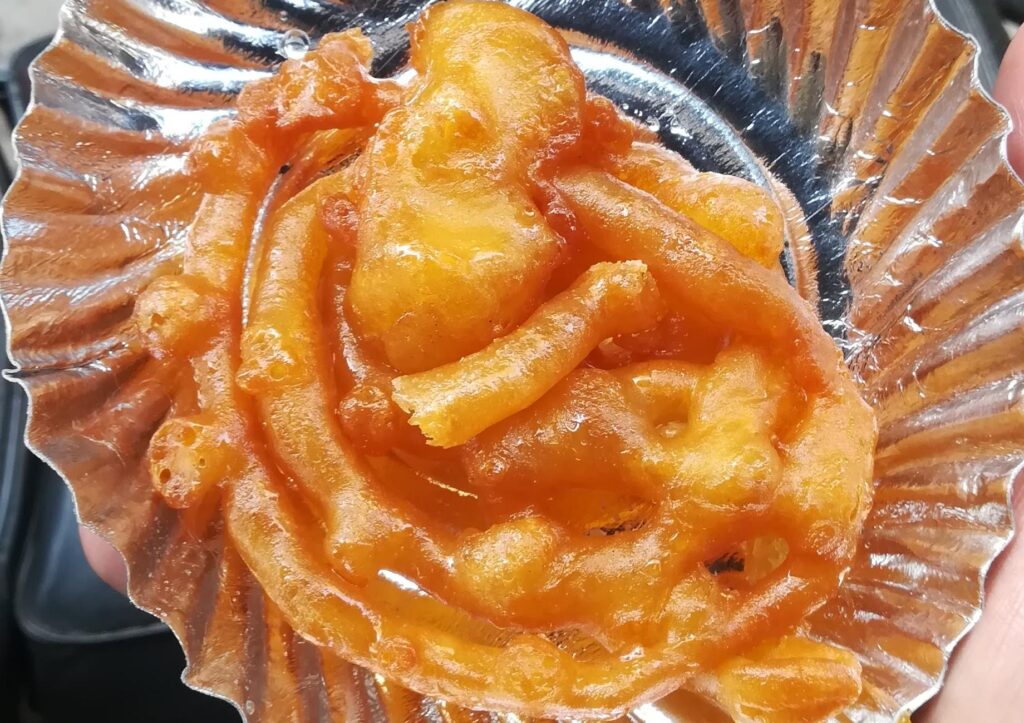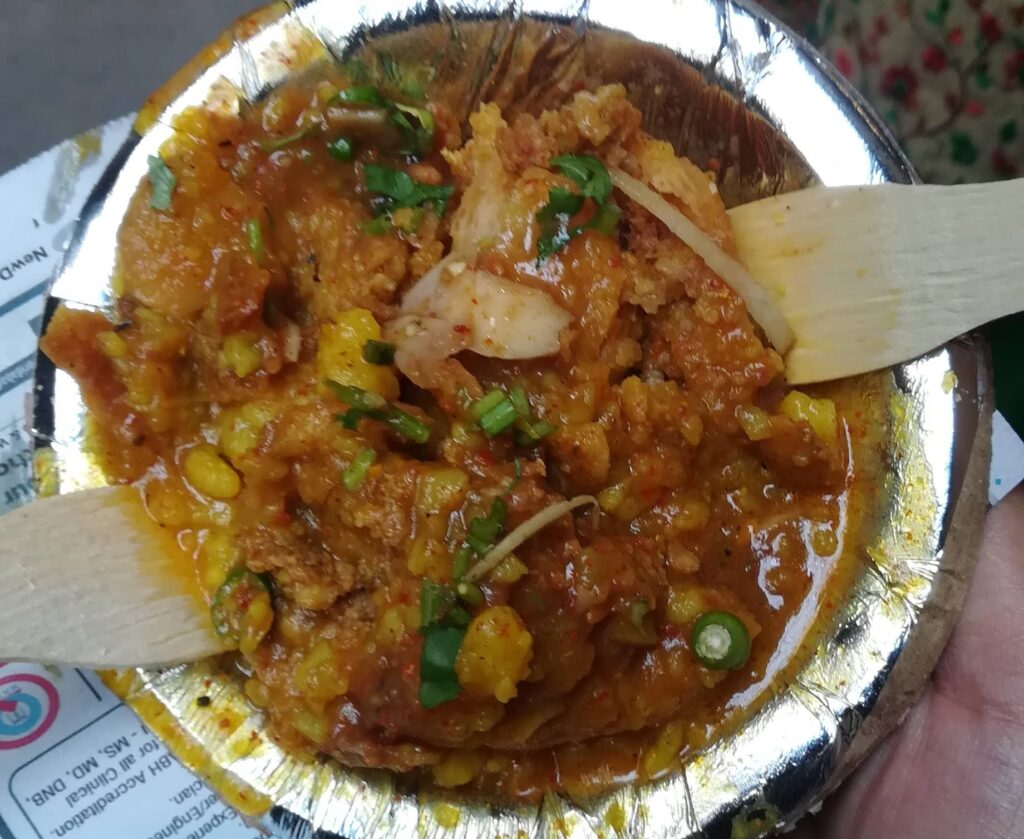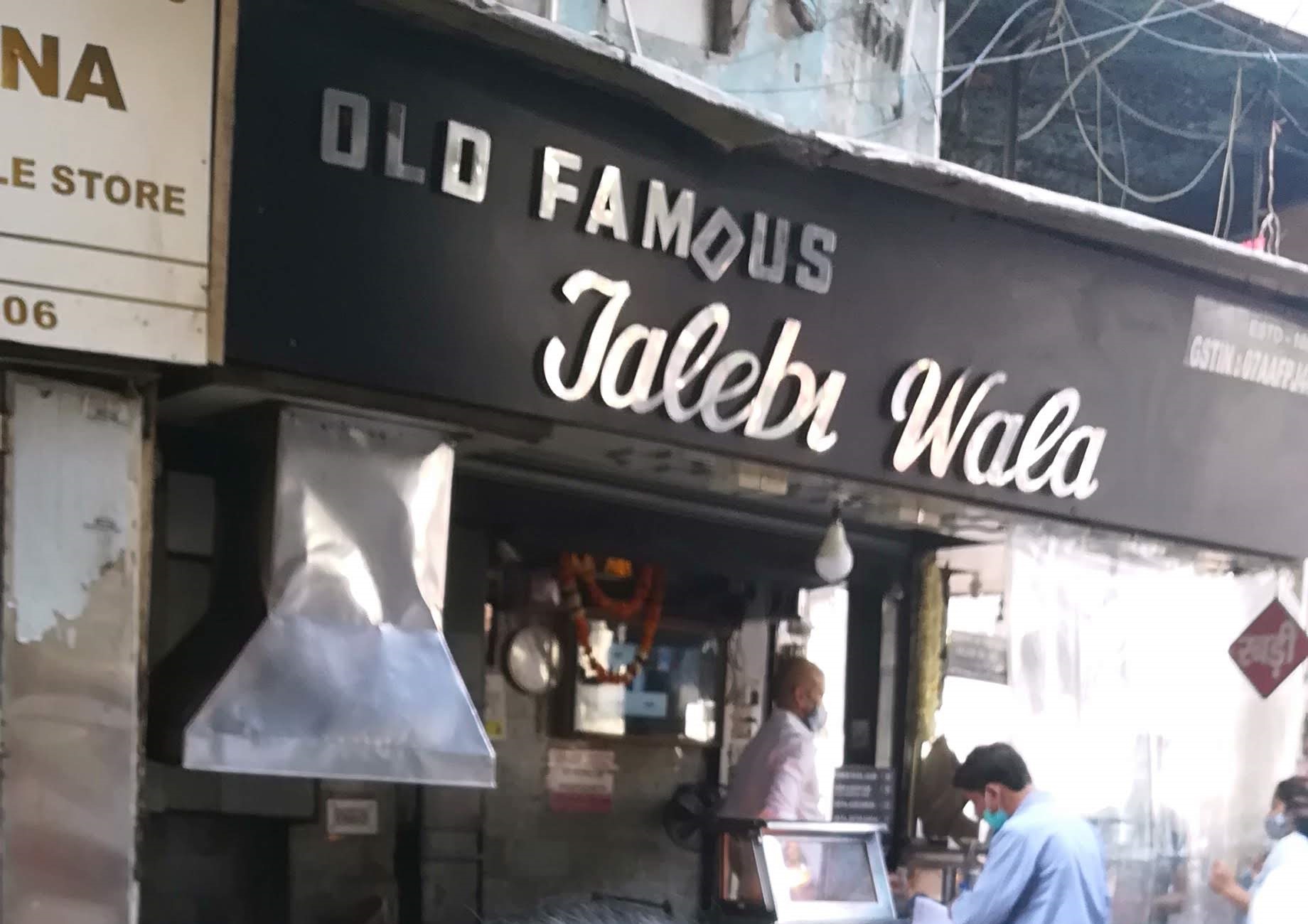[tta_listen_btn]
Who hasn’t heard of Chandni Chowk? Whether you have visited it or not, it is quite likely that, if you live in India, you have at least heard of it.
However, Chandni chowk has a rich history that most are unaware of, even if they have visited. We will create a separate post about the history for the history buffs. Most visitors are there for shopping of traditional garments, especially for ladies, electrical goods and even gadgets. Some visit only to know what this famous place is all about. We, obviously, visit for food.
Chandni Chowk is known for vegetarian street food (unlike Matia Mahal), from light snacks to heavy meals to chaats, drinks, and desserts. Some of these shops are more than a century old, such as the Old Famous Jalebi Wala (est. 1884). The thick, fried-in-desi-ghee (clarified butter) jalebis are unique.


At one end of the Chandni Chowk road, the Red Fort end, are the Digambar Jain Temple and Gauri Shankar Temple. The Food Walk starts here. You can use this guide for a satisfying day visiting all famous food joints, if you have the capacity to taste all. Remember to have small quantities at each place, otherwise you will give up after just a few.

Across the road from these temples is the Lajpat Rai Market that is popular for electrical goods. The first stop is at Manohar Dhaba, also known as Japani Samose Wala (Japanese Samosa Seller). Even the Japanese find the name amusing. The multi-layered flaky snack is very much like a vegetable puff (a bakery snack) but is fried. The chholeChickpeas, usually prepared as a curry. Sometimes misspelt as 'chole'. The chickpeas in Chhole are white, not black. More served with these samosas are very popular.
Not far from there is the chaatChaat is a popular category of street foods of India, the uniqueness of which is a range of textures and burst of flavors in one small plate or bowl. It can be cold or hot. It can even have hot and cold components in the same dish, such as cold... More cart of Gupta Ji, which is also known as ‘7 Matkon Wali Chaat’ (ChaatChaat is a popular category of street foods of India, the uniqueness of which is a range of textures and burst of flavors in one small plate or bowl. It can be cold or hot. It can even have hot and cold components in the same dish, such as cold... More of Seven Earthen Pots) because of the unique way this cart is laid out. This stall has been exactly the same for over 60 years, in its layout and the menu.
Come back to the main road and cross over for the Old Famous Jalebi Wala, which we mentioned above. The thick, juicy jalebis are sold with rabdiLighty sweetened grainy condensed milk, usually flavored with cardamom and dry fruits. Rabdi is usually served cold as a dessert drink. The more condensed version is eaten with spoon. Rabdi is a popularly combined with sweets, such as Jalebi, and Falooda (vermicelli) to make other desserts with more textures and... More, but you can choose to take only the jalebi as well. They also sell samose.
Other Side of Gurudwara Sees Ganj in Chandni Chowk
We cross over to the other side of the historic Gurudwara Sees Ganj. The tiraha (road t-point) in front of the Gurdwara is also connected to the Gurudwara’s history. Do read about it in our post about the History of Chandni Chowk. The multi-domed masjid next to the gurudwara, called Sunehri Masjid because of the golden domes, also is linked to an important incident in history, a very bloody one.
Opposite the Sunehri Masjid is a big outlet of Haldiram’s. You may try some of their snacks and namkeens, if you haven’t earlier. You may also take some rest and use the rest room. However, here’s another reminder that there’s lots more to come.
Just after Haldiram’s is Shri Shyam Kanji Corner. it’s another opportunity to have kanji, especially if it’s peak summer, or some of the chaats. Kanji is a sour fermented drink of cumin seeds, served with a light lentil fried dumpling. This stall is unique by the way such a small space is efficiently used, just an orange metal box in which everything is kept and even the owner sits. This uniqueness also seems to attract people to it.

Walk a few steps ahead to find a narrow lane joining the main road. This is one of the lanes that connect with the Chandni Chowk Metro Station. Right at this corner is Natraj Dahi Bhalla. This shop also been in existence since pre-independence (1940). The dahi bhalla (lentil dumplings in sweetened yogurt) are quite simple. People seem to like that simplicity. They also serve aalu tikki (fried potato patties with chutneys, yogurt and masalas) in the winters.
It’s time again to cross the road. Now we are at the ultra-famous Parathe Wali Gali (lane of parathas). This isn’t one shop but a bunch of them selling parathas (stuffed flatbread). Most who have heard of Chandni Chowk also have heard this name. The parathas here are different in flavors as well as how they are made. Usually parathas are pan roasted with a little oil to fry just the surfaces. In this place they are deep fried in ghee. Apart from the popular stuffings, such as potato, vegetable, and paneer they have also experimented with new flavors, which some find interesting. Would you like to try khoya (condensed milk), lemon, green chilies, banana, dry fruit, or sugar parathas?
Go further into the gali and turn right. Few steps ahead, at a crossroad is Jung Bahadur Kachori Wala. You may ask for crushed kachori or whole. It is served with a spicy potato curry, topped with coriander and chopped green chilies.
Pro Tip: If you can’t handle chilies, tell him not to add the coriander topping. It has the chilies premixed. Also, for some reason, the crushed kachoris feel spicier, so choose to be served whole. Order half plate if you want to continue the food walk. One full plate has two kachoris.
– MatiaMahal.com

If you are all spiced up and also feeling heavy, a dose of Daulat ki ChaatChaat is a popular category of street foods of India, the uniqueness of which is a range of textures and burst of flavors in one small plate or bowl. It can be cold or hot. It can even have hot and cold components in the same dish, such as cold... More may help. But, only in winters. Khemchand Daulat ki ChaatChaat is a popular category of street foods of India, the uniqueness of which is a range of textures and burst of flavors in one small plate or bowl. It can be cold or hot. It can even have hot and cold components in the same dish, such as cold... More is just ahead of the turn into Parathe Wali Gali, while returning from Jung Bahadur. This is nothing like other chaats. You would lick it, but it isn’t spicy or even savory. It’s a lightly sweetened milk froth, topped with some castor sugar, powdered condensed milk, and chopped dry fruits.
Tired? You may come out to the main road of Chandi Chowk and take a rickshaw for Fatehpuri Masjid. Read more about Fatehpuri Masjid in our history blog. On the way keep an eye out for the Town Hall on the right and Ballimaran on the left. The Town Hall (then a sarai/hotel) was first constructed by Shah Jahan’s daughter, Jahan Ara, who also envisioned the entire Chandni Chowk market. In the middle of what’s now the main road used to be a canal, which made a small pond outside the Town Hall. The reflection of the moon in this pond inspired the name Chandni Chowk (moonlight crossroad). Ballimaran lane has the haveli of the most famous Urdu poet, Mirza Ghalib.
If it’s winters, you may leave the rickshaw at the entrance of Fatehpuri Masjid and try some halwas at Chaina Ram Sindi Halwai. The shop opened in 1901 in Lahore (now in Pakistan) and moved to Delhi after partition. Try gajar halwa (carrot fudge), mung dal halwa (lentil fudge), habshi halwa (literally, negro fudge, because of its dark color).
We’ll end the food walk at Giani Di Hatti. Just a little distance towards the right from the masjid. This was established in 1956, again by migrants from Pakistan. It is famous for rabdiLighty sweetened grainy condensed milk, usually flavored with cardamom and dry fruits. Rabdi is usually served cold as a dessert drink. The more condensed version is eaten with spoon. Rabdi is a popularly combined with sweets, such as Jalebi, and Falooda (vermicelli) to make other desserts with more textures and... More faluda (condensed milk with vermicelli) and chholeChickpeas, usually prepared as a curry. Sometimes misspelt as 'chole'. The chickpeas in Chhole are white, not black. More bhatureSpongy, inflated, leavened fried flatbread. Singular is Bhatura. Bhature are made with all-purpose wheat flour. The dough is naturally fermented for the net-like texture and softness. However, many makers make it unfermented due to the lack of time or correct recipe. To get the fluffiness a leaving agent may be... More. In winters you can also enjoy halwas.
Hope you enjoyed the food walk. There are many more gems around this place but we can only visit a few. So, we showed you the most famous ones. Maybe, in another post, we will show you the lesser known ones, or the ones only the locals know.
To stay updated about new posts and information, subscribe to our newsletter.




[…] paradise that showcases the essence of Indian food in all its glory. From savory street snacks in Chandni Chowk to mouthwatering kebabs of Matia Mahal, this vibrant hub is a haven for flavors that will tantalize […]